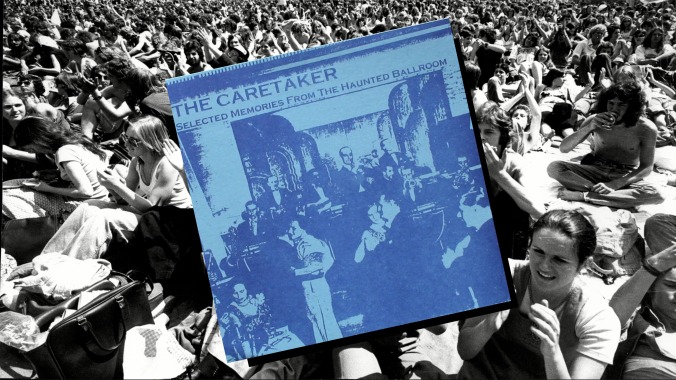Time Capsule: The Caretaker, Selected Memories From the Haunted Ballroom
17 years before making one of the most audacious and groundbreaking ambient projects ever, James Leyland Kirby's debut album as the Caretaker was an innovative introduction to hauntology at the time of its release, even if hindsight has damaged the longevity of its usefulness.

Before his work became a TikTok trend during the COVID-19 pandemic, the Caretaker burst into my view thanks to one of my nightly descents into a Wiki-hole. It was Christmas Time 2016, my family’s first without my grandmother. She’d died a month earlier, just a week before Thanksgiving, from dementia, which she’d been living with for seven-ish years. I had, in my own way, been grieving her death nearly a decade before it actually came, but it wasn’t until after that I started reading about the disease that slowly stripped her for parts. You quickly learn the reality of dementia, that the findings we do have on it yield very few answers. No amount of internet scrolling can take away the truth: It’s a terminal ailment with no cure, and there’s virtually no treatment of ease for the people living with it. You cannot slow dementia down; it’s an erosion somebody lives with and somebody watches. There’s no surrender there.
By late 2016, the Caretaker had already released Stage 1 of his Everywhere at the End of Time recording, a six-part, six-hour project of degrading loops of sampled ballroom music. The idea was to portray the lifespan of dementia, from diagnosis to death. Releasing each “stage” six months apart, it took three years for Everywhere at the End of Time to arrive in full. And when it did, it was meant to be a final goodbye from James Leyland Kirby to the alias he had introduced 20 years earlier. It was an experimental and plundering success, of ballroom songs unraveled into nauseous, claustrophobic expiration. Stage 1 is the part of the record I return to now, because it is the most pleasant of the six chapters—though there is no part of Everywhere at the End of Time with a grievous splendor like “Libet’s delay,” the rosy, eerie centerpiece of An Empty Bliss Beyond This World. I listened to all six hours of Everywhere at the End of Time consecutively and I’ll never do it again.
The song titles are meant to convey a dementia patient’s emotions, and some are far more upsetting than others, like “Aching cavern without lucidity,” “A confusion so thick you forget forgetting” and the preposterously damaging “I still feel as though I am me.” Neurological researchers were supportive of the album, calling the transition from calm to confusion a “chilling reality” and “a much welcome thing” in the world of dementia patient caretakers. At its most deconstructed, Everywhere at the End of Time remains full of empathy. It’s scary and frustrating, a fall into blistering, noisy static inexplicably othered by itself. You can’t piece it out; the dilapidation is simply too much. And yet, even in regression, there is still music. Even on her deathbed, my grandmother sang. Now, when I hear “The way ahead feels lonely,” I weep while its decaying whimsy hits me like a Pavlovian response for grief.
Kirby is perhaps one of our strangest and most-provocative living curators. His work dares to turn its listeners inside out. The Quietus’s Jon Fletcher wrote 17 years ago that the Caretaker’s music was “British tea-room pop plugged into a multitude of effects to create a Proustian Replicant inverse,” and that it’s “a stranger’s past relocated within your own memories, a reimagined history from an alien past.” That’s a good way to say “hauntology” without actually saying it. Derivative of Jacques Derrida’s neological thesis on the matter—how interrogations of the past, socially or culturally, can be spectral—hauntology first showed up in a book of his, Spectres of Mark, in 1993. Within 10 years, it became a genre popularlized, loosely, by electronic musicians like Burial and Philip Jeck in mid-2000s Britain. Hauntology, in music, was theorized by critic Simon Reynolds and blogger k-punk, and the genre’s effort worked well on intrigue alone.
Hauntology was this cut-and-paste collaging and meshing of audio from “library music,” aka film and television soundtracks and public information films. Artists stacked the samples on top of each other, drowning the source melodies in thick, soupy washes of noise and drone. The idea was to make a listener remember; the nostalgic compositions of the now, like hypnagogic pop or even something more widescreen, like chillwave, are descendants of Derrida’s deconstructive concepts. In the company of hauntology, we are anthropologists. The Caretaker’s work, across 20 years, was sometimes too uncanny for the valley.
The Caretaker’s debut album, Selected Memories From the Haunted Ballroom, is not a spectacular introduction by any means. It’s a rough-around-the-edges, milquetoast manipulation of 1920s music. Kirby had found influence in The Shining and wanted to make a record that could have played throughout the Overlook Hotel when the cameras weren’t rolling. Boil it down to the bones and the LP is aural fan-fiction. At the time, Selected Memories was a detour from Kirby’s previous work, namely his pop-to-noise deconstructions under the V/Vm alias. So, rather than cutting up rave instrumentals, he started slowing down big band records and adding atmosphere to them. All he had was a turntable, a DAW and effects. The Caretaker alias was meant to be a survey of nostalgia before it became a vehicle for memory. Later on in his career, before his An Empty Bliss Beyond This World breakthrough, Kirby had explored the effects of amnesia. The reception among critics remained favorable.
-

-

-

-

-

-

-

-

-

-

-

-

-

-

-

-

-

-

-

-

-

-

-

-

-

-

-

-

-

-

-

-

-

-

-

-

-

-

-

-








































